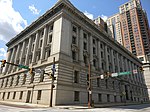Baltimore World Trade Center

Located on the Inner Harbor of Baltimore, Maryland, the Baltimore World Trade Center is the world's tallest regular pentagonal-based skyscraper (the pentagonal-based JPMorgan Chase Tower in Houston is taller, but is not regular). It was designed by the architectural firm Pei Cobb Freed & Partners, with the principal architects being Henry N. Cobb and Pershing Wong.Planning and design of the building began in April 1966. Construction started in October 1973. The building was completed in January 1977, and its construction cost was of $22 million.Rising 405 ft (123 m) above the one-acre plaza where it stands between Pratt Street and the harbor, the building is 30 stories tall when its basement, lobby level and upper utility level are included in the count. Gross floor space covers 422,000 sq ft (39,200 m2). Major building components include 309,000 sq ft (28,700 m2) of office floors, a lobby of 13,000 sq ft (1,200 m2), a basement of 20,800 sq ft (1,930 m2) and 38,000 sq ft (3,500 m2) of ground level plaza.
Excerpt from the Wikipedia article Baltimore World Trade Center (License: CC BY-SA 3.0, Authors, Images).Baltimore World Trade Center
East Pratt Street, Baltimore
Geographical coordinates (GPS) Address External links Nearby Places Show on map
Geographical coordinates (GPS)
| Latitude | Longitude |
|---|---|
| N 39.286016666667 ° | E -76.609658333333 ° |
Address
World Trade Center
East Pratt Street 401
21202 Baltimore
Maryland, United States
Open on Google Maps









